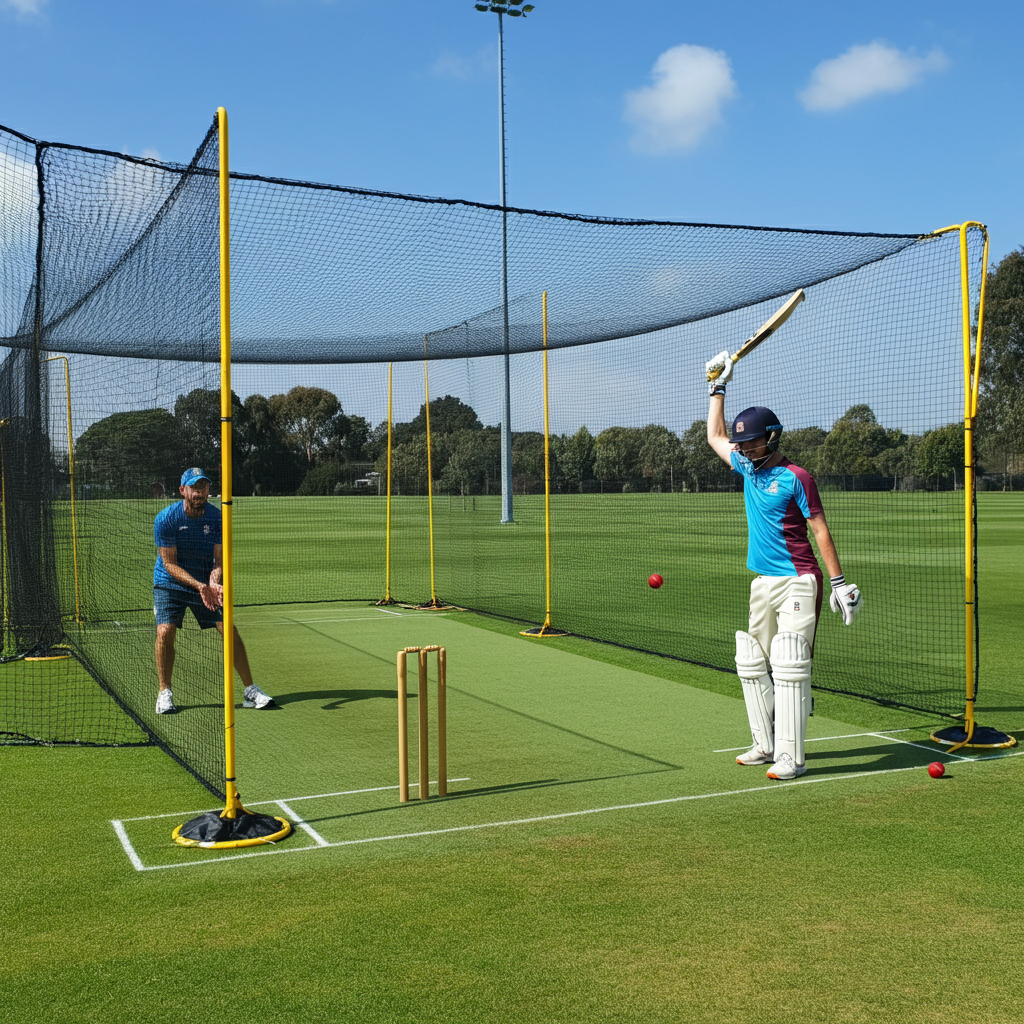
Introduction
For many, cricket is a way of life rather than just a sport. Cricket is a game that demands accuracy, skill, and practice. To get players ready for games, training setups are crucial. The cricket net is one such essential training aid. In order to improve your skills, cricket nets are essential, regardless of your level of experience. Let’s examine every aspect of cricket nets, including types, advantages, upkeep, and potential developments.
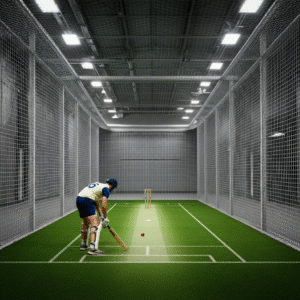
What Are Cricket Nets and Why Are They Important?
By keeping the cricket ball in a specific area, cricket nets are specialized enclosures made to make cricket practice easier. These nets usually have netting behind, on either side, and occasionally on top of a cricket pitch. The main goal is to give bowlers and batters the freedom to practice without having to worry about recovering the ball or damaging neighboring properties.
The importance of cricket nets cannot be overstated. They:
- Save time during practice sessions by reducing distractions.
- Allow multiple players to train simultaneously.
- Provide a safe and controlled environment.
- Eliminate the need for fielders during practice, making solo sessions possible.
With cricket nets, practice becomes not only efficient but also more focused.
Types of Cricket Nets
Cricket nets vary from one another. The structure and function of cricket nets vary according to the training goals and available space. A closer look at the most prevalent kinds is provided below:
1. Indoor Cricket Nets
Usually, cricket academies or sports halls have indoor cricket nets. When not in use, the nets can be readily pulled out or retracted thanks to the runner system that suspends them from the ceiling. Indoor nets are:
- Designed for all-weather use.
- Usually white, with a canvas enclosure near the batters for extra durability.
- Ideal for locations with harsh winters or rainy climates.
2. Outdoor Cricket Nets
These are the most widely used nets in clubs, schools, and even backyard gardens. Outdoor cricket nets are made from weather-resistant materials and feature:
- Frames made of heavy-duty steel or aluminum to support the structure.
- Netting made of UV-stabilized polymers like polyethylene or nylon.
- A focus on durability to handle high usage and extreme weather.
Outdoor nets often have multiple lanes, making them suitable for larger groups.
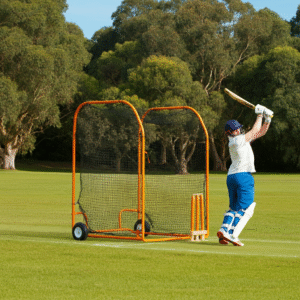
3. Mobile Cricket Nets
Mobile cricket nets are versatile and offer convenience for temporary training setups. These nets:
- Have wheeled bases, allowing them to be moved across fields.
- Are popular among cricket clubs that share playing grounds with other sports.
- Can be used for warm-up sessions before matches.
4. Fixed Cricket Nets
Fixed cricket nets are permanently installed in one location. Their frames are embedded into concrete bases for stability. These nets:
- Are commonly seen in professional cricket grounds or outdoor facilities catering to high traffic.
- Include features like pulley systems for easy maintenance.
5. Pop-Up Cricket Nets
Pop-up cricket nets are a lightweight and practical choice for players who like portable solutions. These easy-to-assemble nets are great for informal practice.
Because each kind of cricket net has a distinct function, it is crucial to base your decision on your needs.
Materials Used in Cricket Nets
Cricket net performance and durability are greatly influenced by the materials used. The most often used materials are listed below:
1. Nylon
Known for its high tensile strength, nylon is widely used in cricket nets. It is:
- Durable and resistant to wear and tear.
- Ideal for heavy-duty use in both indoor and outdoor setups.
- More expensive than other materials.
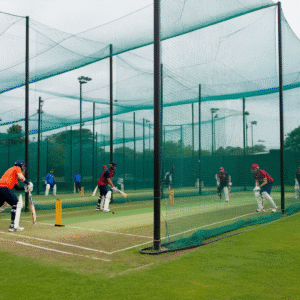
2. Polyethylene (PE)
Polyethylene is the more affordable alternative to nylon. It is:
- UV-stabilized to withstand exposure to sunlight.
- Lightweight, but may not last as long as nylon when subjected to heavy use.
3. Galvanized Steel
This material is mainly used for the frames of outdoor nets. Galvanized steel:
- Resists rust and corrosion, making it perfect for long-term use.
- Provides a sturdy frame that can handle the weight of heavy netting and withstand high winds.
4. Canvas
Canvas is rarely used for the entire net, but it is often added as strips or skirts near the batter. It:
- Enhances durability for high-impact areas.
- Helps focus the batter’s attention by eliminating visual distractions.
When investing in cricket nets, understanding these materials ensures you get excellent value for your money.
Benefits of Using Cricket Nets
Why use cricket nets? Here are the top benefits:
- Enhanced Training Efficiency: Solo practice becomes easy when a net keeps the ball within reach.
- Safe Environment: Nets contain balls, reducing the risk of injury to bystanders or damage to surrounding property.
- Improved Skills for All Levels:
- Beginners gain confidence without fear of losing balls.
- Professional players refine their techniques with uninterrupted sessions.
- Adaptability: Nets work well with bowling machines, offering a realistic match simulation.
For cricket enthusiasts, nets are a game-changer, offering endless advantages for player development.
How to Choose the Right Cricket Net for Your Needs
Selecting the perfect cricket net requires careful consideration. Here’s what you should keep in mind:
-
Purpose:
- Are you buying for solo home practice, or do you need professional-grade nets for a club?
-
Space:
- Measure the area where you plan to install the net.
-
Frequency of Use:
- For daily use, invest in high-quality nylon nets.
-
Portability:
- Opt for pop-up or mobile nets if you need temporary or movable setups.
-
Budget:
- While polyethylene nets are economical, nylon may provide better longevity.
Compare features across products to make a well-informed decision.
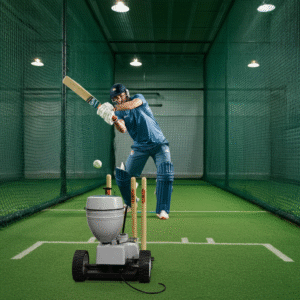
Maintenance Tips for Cricket Nets
To prolong the life of your cricket nets, follow these maintenance tips:
-
Regular Cleaning:
Remove dirt and debris from both the netting and the frame to avoid wear. -
Inspect for Damage:
Check the seams and netting regularly for tears or weak spots. -
UV Protection:
Use UV-resistant sprays for nets exposed to sunlight. -
Proper Storage:
Retract or cover nets when not in use, especially for portable or indoor setups. -
Check Metal Frames:
Examine for rust or loose couplings in outdoor fixtures.
Routine care saves you money and ensures the nets stay safe to use.
Popular Brands and Products in the Market
When it comes to cricket nets, several brands dominate the market. Here are some worth considering:
-
Fortress Cricket Nets:
Known for their durable and versatile pop-up models. -
Net World Sports:
Offers high-quality batting cages with various options for backyard or club use. -
Nets of America:
Specializes in customizable cricket cage nets made of premium knotted nylon. -
All Rounder Cricket:
Provides garden nets and professional-grade products.
Each brand brings something unique to the table, catering to both amateurs and seasoned players.
DIY Cricket Nets for Home Use
Love cricket but can’t invest in professional nets? A DIY cricket net may be your solution. Here’s how to build one:
Materials Needed:
- UV-stabilized netting.
- PVC or galvanized steel pipes for the frame.
- Rope or cable for securing the net.
Steps:
- Construct the frame by attaching pipes with T-joints.
- Secure the frame into the ground using sandbags or stakes.
- Hang the net on the frame using hooks or zip ties.
And voila! You have a budget-friendly cricket net right in your backyard.
Safety Considerations When Using Cricket Nets
Safety should always be a priority when setting up or using cricket nets:
-
Ensure Stability:
Check that the net frame is secure, especially for outdoor setups. -
Supervise Young Players:
Avoid injury by ensuring children practice under adult supervision. -
Wear Safety Gear:
Batters should always use helmets and proper padding during practice. -
Position Nets Away from People:
Keep nets far from areas frequented by bystanders to minimize risk.
By adhering to these guidelines, you create a safe practice environment for everyone.
Future Trends in Cricket Net Technology
The cricketing world is evolving, and so are cricket nets. Here’s what the future holds:
- Smart Nets:
- Integrated sensors to track ball speeds or trajectories.
- Eco-Friendly Materials:
- Ropes and netting made from biodegradable or recycled materials.
- Retractable Systems:
- Automated retraction mechanisms for indoor setups.
- High-Impact Resistance:
- Specialized materials to handle fast-paced practice sessions.
These advancements promise safer, more efficient training sessions with top-tier technology.
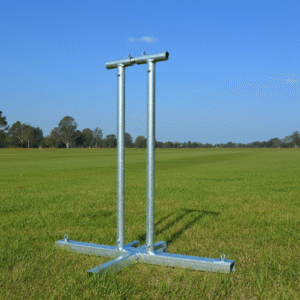
Final Thoughts
In the game of cricket, cricket nets are indispensable. They offer an unrestricted setting for training, education, and skill development. This guide gives you all the information you need to make wise decisions, from knowing the types and materials to maintaining and selecting the best net. Cricket nets give you the edge on the field, whether you’re practicing in your backyard or at a professional facility.





Leave a Reply